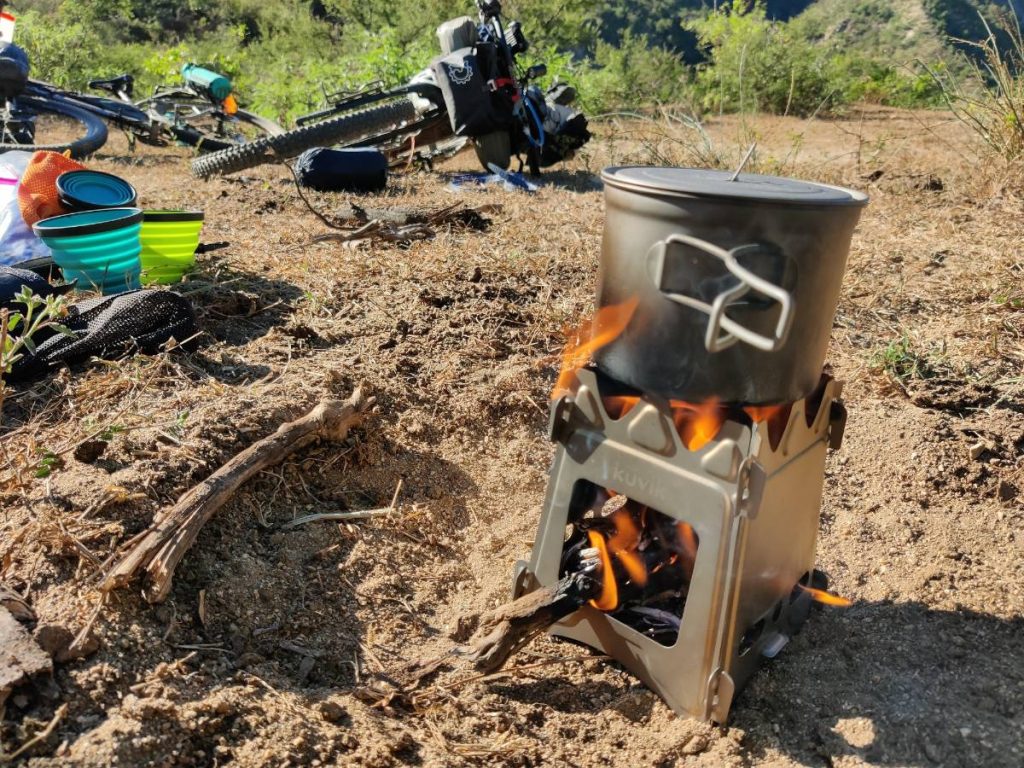Gear Notes
The Cape Loop is fairly simple to gear up for due to its moderate climate and frequent resupply. I carried most of my usual bikepacking gear list for short trips, with a few notable modifications.
Stove
I usually like to bikepack with a stove, but the Cape Loop’s combination of frequent towns and relatively warm weather make going stoveless less of a sacrifice. You could enjoy hearty dinners of tortillas, refried beans (available everywhere in lightweight pouches), and avocado and tomato. Breakfast could be granola and milk powder. Instant coffee works fine in cold water. If you want a very lightweight meal, cold-soak a ramen cup.
We did bring a stove, but not our usual. Isobutane canisters seem impossible to buy in Baja, and while I’m sure you can find fuel for a liquid stove it can be a hassle to track down the right stuff. We decided to try out this little wood-burning stove, which cost $35 and weighs only 7 ounces with no need to carry fuel.
How did it go? There’s a bit of a learning curve and patience is required; we gave up once on a windy beach and just cold-soaked our ramen. Dry fuel is easy to find, but the right tinder and kindling is crucial. We brought cotton balls soaked with Vaseline as a firestarter and this helped a lot.
Worth it? It was nice to have hot ramen and coffee, but I would say it was almost not worth the effort since we also enjoyed our stoveless meals of tortillas and refried beans.

Warm Clothes
This part of Baja can cook during the day, but nights can still be chilly. You certainly don’t need the kind of cold weather gear you would want on something like the Great Divide, but folks who go without any kind of warm stuff generally regret it. Expect temps down into the low 50’s at night in the mountains, and the beaches can be chilly due to wind. Depending on when you ride and what the weather patterns are, you might want to be prepared for an occasional night in the high 40’s.
Here’s what I brought to keep warm, which ended up being perfect:
- Lightweight down puffy (Ghost Whisperer)
- Lightweight rain jacket (OR Helium) – very useful for wind too
- Light merino base layer top for sleeping and going out in the evenings in town
- Tights for sleeping and going out in the evenings in town
- Sleeping quilt rated to around 30 degrees, which was plenty warm
Some warm things I often bring on bikepacking trips that I didn’t bring or need on this one: warm gloves, rain pants, warm hat.
Elkhorn Cargo Cage Rack
I was tempted to run a seat bag on this trip to keep the weight down, but I went with an OMM Elkhorn Rack and it ended up being a great choice for several reasons. The biggest is that I was able to still use my dropper seatpost, not strictly necessary for this ride but nice to have on some of the rougher descents.
It’s also a nice way to organize cargo. It’s a medium-capacity setup, more than a seat bag and less than my bikepacking panniers, which was perfect for this ride. The rack deck simplifies carrying extras like more water or food for certain stretches. It’s also probably the most organized I’ve ever been on a bikepacking trip, with two separate small dry bags instead of a single seat bag or big panniers.
Shelter and Sleep
We broke out our old Tarptent Double Rainbow for this trip and it was a great compromise, if a bit cozy. We do longer bikepacking trips with our 3-person Big Agnes Copper Spur (that extra space is crucial when on the road for awhile) but it seemed overkill for this route.
In hindsight we could have gotten away with our ultralight water-resistant bivvies, essentially just “cowboy camping” under clear skies. But it was nice to have private space at some of the campgrounds / hostels. Also, it does sometimes rain in Baja, though we didn’t experience any.

Our Tarptent Double Rainbow worked well for this trip
Beach Stuff
We spent five whole off-bike days at beaches around the loop, and these were essential for enjoying that time:
- Swimsuit
- Athletic shorts and tank top
- Stuffable ultralight backpack
- Sports sandals
- Lots of sunscreen
- Sunglasses and sunglass retainer strap for water sports
 CampingSurvivalistHuntingFishingExploringHikingPrivacy PolicyTerms And Conditions
CampingSurvivalistHuntingFishingExploringHikingPrivacy PolicyTerms And Conditions
